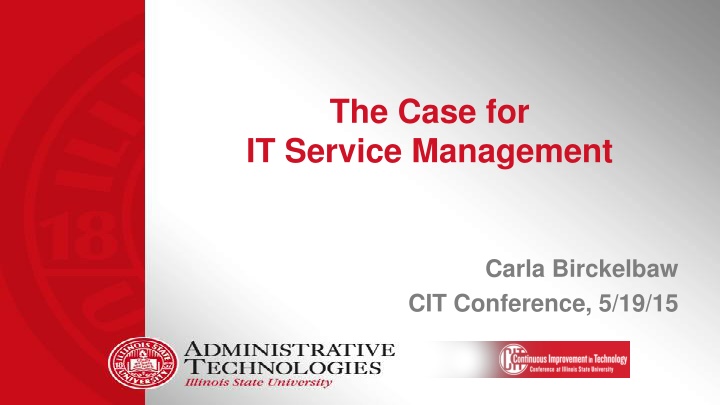
Implementing IT Service Management for Improved Efficiency
Discover the benefits of IT Service Management (ITSM) and its implementation at ISU, focusing on maturing service management practices, tool selection, and managing chaos through tracking and prioritizing work. Find out how ITIL and ITSM processes can enhance IT service delivery, leading to consistency, transparency, and integrated processes.
Download Presentation

Please find below an Image/Link to download the presentation.
The content on the website is provided AS IS for your information and personal use only. It may not be sold, licensed, or shared on other websites without obtaining consent from the author. If you encounter any issues during the download, it is possible that the publisher has removed the file from their server.
You are allowed to download the files provided on this website for personal or commercial use, subject to the condition that they are used lawfully. All files are the property of their respective owners.
The content on the website is provided AS IS for your information and personal use only. It may not be sold, licensed, or shared on other websites without obtaining consent from the author.
E N D
Presentation Transcript
The Case for IT Service Management Carla Birckelbaw CIT Conference, 5/19/15
What is IT Service Management? ITSM - and ITIL, upon which it is based - are an integrated, process-based, set of best practices to manage IT services. Whereas ITIL defines and documents the best practices, ITSM employs them to meet unique customer requirements and priorities.
What is IT Service Management? Source: www.elitser-me.com
IT Service Management at ISU Many IT teams interested in ITIL and gaining certifications, working to mature their processes + Both ITSM tools in use nearing End of Life + Current tools not meeting all needs _____________________________________ A campus IT community ready for a change
IT Service Management at ISU Moving to a common ITSM process and searching for a common ITSM tool ITSM tool RFP Cherwell chosen, Avante as implementation partner Process discussions continuing throughout
Why implement IT Service Management? We can mature our service management practices through careful configuration of the ITSM tool
Maturing our service management Consistency Transparency Complex reporting Intuitive Linked records Searching across all records = integrated processes
Why implement IT Service Management? Tracking and prioritizing our work controls the chaos
Tracking and Prioritizing Controls the Chaos Urgency: A measure of how long it will be until an Incident has a significant Impact on the organization. For example, a high Impact Incident may have low Urgency, if the Impact will not affect the organization until the end of the financial year. Urgency 1- Incident causes significant disruption affecting critical business processes, academic services or affects life safety, workaround is available. Impact: A measure of the effect of an Incident based upon the number of clients affected. Urgency 2- Incident causes a significant disruption to critical business processes, but not affecting life safety or academic services, and no Urgency 3- Incident will cause a disruption in the near term, a workaround is available Urgency 4- Work not affected or readily available work around All of campus affected Learning Spaces or multiple departments\ residence halls Several people or a single department or residence hall One person Critical (P1) Critical (P1) High (P2) Normal (P3) Critical (P1) High (P2) Normal (P3) Low (P4) High (P2) High (P2) Normal (P3) Low (P4) High (P2) Normal (P3) Normal (P3) Low (P4) affected
Why implement IT Service Management? It makes IT more efficient, increasing response time for our customers
Why implement IT Service Management? Asset and Configuration Item tracking is integral to the process
Why implement IT Service Management? Federating our collective IT knowledge benefits everyone
Federated knowledge benefits everyone Knowledge Article #### Internal Review Published Retired Status Next Status Last Modified: Autofill of date and View Knowledge Article user Edit Owned By: Assign To Photo, name, phone, email Title: Keywords: Voting Content: Useful Not Useful Useful (count) Not Useful (count) I Want To Take Ownership Add Comment View Detailed Date/Time Information Suggest a Knowledge Article Retire this Article Limit viewing to owner Visible in Customer Portal Limit editing to owner Audience: drop down list Classification ITSM Continuous Improvement Provide Feedback on the ITSM ITSM Feature Request Service: [drop down from Service Catalog] Article Type: Category: [drop down from Service Catalog] Primary CI: picker from CMDB Subcategory: [drop down from Service Catalog]
Why implement IT Service Management? Meeting customer expectations
Why implement IT Service Management? We can measure our performance and prove it with data
Why implement IT Service Management? Align with University goals
Why implement IT Service Management? Why not implement IT Service Management?
ITSM Project Timeline Phase 1 (Go live summer 2015) Phase 2 (Go live summer/early fall 2015) Incident Management Request Fulfillment Self-Service Portal Customer Profile Populated Phase 3 (go live November 2015) Phase 4 (Go live March 2016) Change Management Knowledge Management Service Catalog CMDB Infrastructure CI types Basic Authentication Email Integration Basic Discovery Tool Integration Customer Profile Setup Named users established Security Groups Service Level Management Release Management SCCM Integration New Discovery Tool integration* CMDB Endpoint CI types Problem Management CMDB remaining CI types Reservation Manager Lightspeed Replacement** Project/Portfolio Management** All phases have a corresponding development cycle workshops, requirements, configuration, training, User Acceptance Testing, and Go Live. * Dependent upon release of new discovery tool by Cherwell ** Optional implementations, decisions pending
Questions? ITSM Project contacts Carla Birckelbaw, crbirck@ilstu.edu Shane Thomison (PM), smthomi@ilstu.edu
